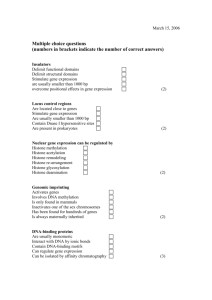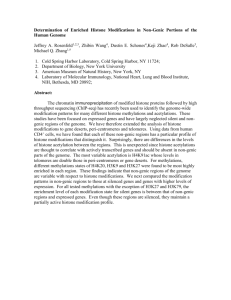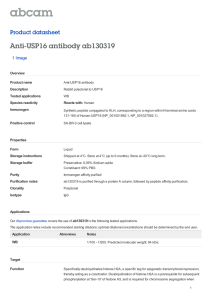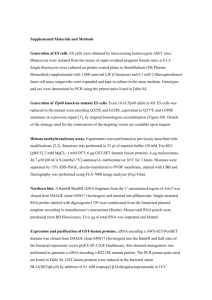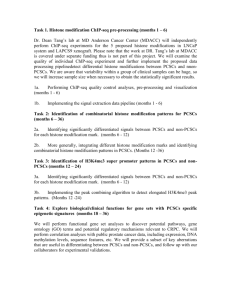Advance Journal of Food Science and Technology 5(2): 119-126, 2013
advertisement
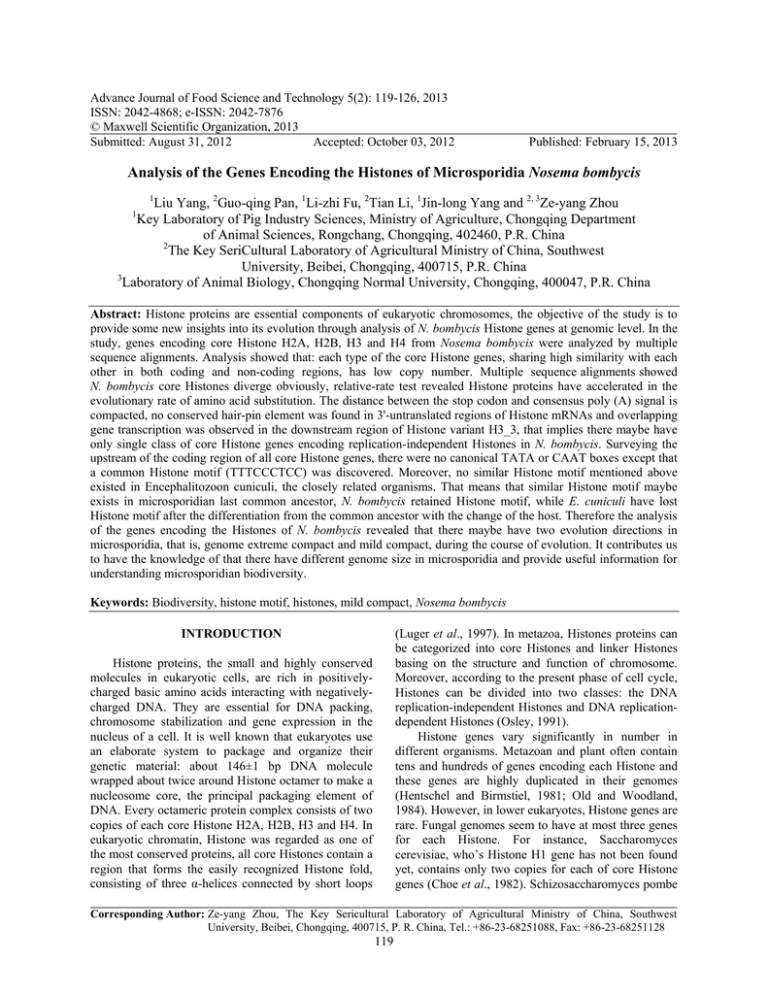
Advance Journal of Food Science and Technology 5(2): 119-126, 2013 ISSN: 2042-4868; e-ISSN: 2042-7876 © Maxwell Scientific Organization, 2013 Submitted: August 31, 2012 Accepted: October 03, 2012 Published: February 15, 2013 Analysis of the Genes Encoding the Histones of Microsporidia Nosema bombycis 1 Liu Yang, 2Guo-qing Pan, 1Li-zhi Fu, 2Tian Li, 1Jin-long Yang and 2, 3Ze-yang Zhou Key Laboratory of Pig Industry Sciences, Ministry of Agriculture, Chongqing Department of Animal Sciences, Rongchang, Chongqing, 402460, P.R. China 2 The Key SeriCultural Laboratory of Agricultural Ministry of China, Southwest University, Beibei, Chongqing, 400715, P.R. China 3 Laboratory of Animal Biology, Chongqing Normal University, Chongqing, 400047, P.R. China 1 Abstract: Histone proteins are essential components of eukaryotic chromosomes, the objective of the study is to provide some new insights into its evolution through analysis of N. bombycis Histone genes at genomic level. In the study, genes encoding core Histone H2A, H2B, H3 and H4 from Nosema bombycis were analyzed by multiple sequence alignments. Analysis showed that: each type of the core Histone genes, sharing high similarity with each other in both coding and non-coding regions, has low copy number. Multiple sequence alignments showed N. bombycis core Histones diverge obviously, relative-rate test revealed Histone proteins have accelerated in the evolutionary rate of amino acid substitution. The distance between the stop codon and consensus poly (A) signal is compacted, no conserved hair-pin element was found in 3'-untranslated regions of Histone mRNAs and overlapping gene transcription was observed in the downstream region of Histone variant H3_3, that implies there maybe have only single class of core Histone genes encoding replication-independent Histones in N. bombycis. Surveying the upstream of the coding region of all core Histone genes, there were no canonical TATA or CAAT boxes except that a common Histone motif (TTTCCCTCC) was discovered. Moreover, no similar Histone motif mentioned above existed in Encephalitozoon cuniculi, the closely related organisms. That means that similar Histone motif maybe exists in microsporidian last common ancestor, N. bombycis retained Histone motif, while E. cuniculi have lost Histone motif after the differentiation from the common ancestor with the change of the host. Therefore the analysis of the genes encoding the Histones of N. bombycis revealed that there maybe have two evolution directions in microsporidia, that is, genome extreme compact and mild compact, during the course of evolution. It contributes us to have the knowledge of that there have different genome size in microsporidia and provide useful information for understanding microsporidian biodiversity. Keywords: Biodiversity, histone motif, histones, mild compact, Nosema bombycis (Luger et al., 1997). In metazoa, Histones proteins can be categorized into core Histones and linker Histones basing on the structure and function of chromosome. Moreover, according to the present phase of cell cycle, Histones can be divided into two classes: the DNA replication-independent Histones and DNA replicationdependent Histones (Osley, 1991). Histone genes vary significantly in number in different organisms. Metazoan and plant often contain tens and hundreds of genes encoding each Histone and these genes are highly duplicated in their genomes (Hentschel and Birmstiel, 1981; Old and Woodland, 1984). However, in lower eukaryotes, Histone genes are rare. Fungal genomes seem to have at most three genes for each Histone. For instance, Saccharomyces cerevisiae, who’s Histone H1 gene has not been found yet, contains only two copies for each of core Histone genes (Choe et al., 1982). Schizosaccharomyces pombe INTRODUCTION Histone proteins, the small and highly conserved molecules in eukaryotic cells, are rich in positivelycharged basic amino acids interacting with negativelycharged DNA. They are essential for DNA packing, chromosome stabilization and gene expression in the nucleus of a cell. It is well known that eukaryotes use an elaborate system to package and organize their genetic material: about 146±1 bp DNA molecule wrapped about twice around Histone octamer to make a nucleosome core, the principal packaging element of DNA. Every octameric protein complex consists of two copies of each core Histone H2A, H2B, H3 and H4. In eukaryotic chromatin, Histone was regarded as one of the most conserved proteins, all core Histones contain a region that forms the easily recognized Histone fold, consisting of three α-helices connected by short loops Corresponding Author: Ze-yang Zhou, The Key Sericultural Laboratory of Agricultural Ministry of China, Southwest University, Beibei, Chongqing, 400715, P. R. China, Tel.: +86-23-68251088, Fax: +86-23-68251128 119 Adv. J. Food Sci. Technol., 5(2): 119-126, 2013 been deposited in GenBank, EMBL and DDBJ databases, their accession numbers are as follows: Histone H1, EU848482; Histone H2A, EU848483; His tcne H2B, EU848484; His tcne H4, EU848485; His tcne H3_1, EU848486; His tcne H3_2, EU848487; His tcne H3_3, EU848488. All his tcnes theoretical pI/Mw values were predicted on ExPASy server (http://www. expasy.ch). Histone homologs from other organisms were retrieved from NCBI database (http://www. ncbi.nlm.nih.gov/) by BLASTP searches, their accession numbers were indicated in supplementary material (Appendix). Histone conservation analysis were carried out with multiple sequence alignments between N. bombycis Histone and its homologs using CLUSTAL-X (Thompson et al., 1997), Histone folds were determined according to the criteria described previously (Gang et al., 2000). The relative-rate test was conducted using RRTree software (Robinson-Rechavi and Huchon, 2000) for comparing the core his tcne from the N. bombycis with the one from Trypanosoma cruzi, whose core his tcnes have been reported acceleration in the evolutionary rate of amino acid substitution in relation to other eukaryotes (Toro et al., 1992). Untranslated regions analysis was done as following: has two H2A genes, one H2B gene paired with one of the H2A genes and three H3-H4 gene pairs (Matsumoto and Yanagida, 1985). Aspergillus nidulans only uses a single gene to encode H2A, H2B, H3, except for two H4 genes (Ehinger et al., 1990). Neurospora crassa has one H2A and H2B gene pair, one H3 gene and two H4 genes (Hays et al., 2002). Recently years, more and more eukaryotic Histone molecules were characterized, while the Histone genes from the unicellular microsporidia received limited attention. Microsporidia are a large group of obligate intracellular parasitic eukaryotes, there are approximately 1,300 described species (Larsson, 1988) and their genome size varies greatly from 2.9-19.5 Mb (Keeling and Fast, 2002). Members of this group differ from most of other eukaryotes in biochemistry and cytology. Their fundamental features are a thick chitin cell wall and environmentally resistant spores with one or two nuclei but without mitochondria (Biderre et al., 1995). Microsporidia have complex life cycles, highly specialized structure and unique infection mechanism, many of them can infect a wide variety of organisms including vertebrate and invertebrate (Frixione et al., 1992). Comparative genomics indicated microsporidian genomes are among the smallest of known eukaryotic genomes. Extreme genome compaction has led to a high frequency of overlapping gene expression (Williams et al., 2005). As one member of the phylum microsporidia, N. bombycis was firstly detected as an agent causing pẻrbrine disease, which nearly destroyed European silkworm industry in mid-19th century (Nageli, 1857). Currently, N. bombycis genome, approximately 15.33 Mb with 18 chromosomes (Kawakami et al., 1994), is being sequenced at our lab. We analyzed N. bombycis Histone genes and provide some new insights into the evolution of microsporidia • • • MATERIALS AND METHODS The promoters in 5'-untranslated regions (5'-UTRs) were predicted by Promoter 2.0 (http:// www.cbs.dtu.dk/services/Promoter/), while stop codon and polyadenylation (polyA) signal in 3'untranslated regions (3'-UTRs) were identified according to typical sequence characteristics DNA multi-aligning was carried out using CLUSTAL-W (Chenna et al., 2003). Potential stem-loop structures in 3'-UTRs were searched on the basis of the previous method (Yee et al., 2007) The study was made in 2011 in Chongqing, China, the relevant research works were carried out or completed in three laboratories that are: Key Laboratory of Pig Industry Sciences, Chongqing Academy of Animal Sciences, Ministry of Agriculture; The Key Seri cultural Laboratory of Agricultural Ministry of China, Southwest University; Laboratory of Animal Biology, Chongqing Normal University. Histone gene comparative genomic analysis were conducted between microsporidia N. bombycis, E. cuniculi and Antonospora locustae, their Histone genes were retrieved from GenBank (http://www.ncbi. nlm. nih.gov/) and A. locustae Genome Project at the Marine Biological Laboratory (http:// jbpc. mbl. edu/ Nosema /index.html). Materials: N. bombycis isolate CQ1, isolated from infected silkworms in Chongqing, was preserved in China Veterinary Culture Collection Center (CVCC, no. 102059). Genome DNA (gDNA) database and Expression Sequence Tags (ESTs) database were obtained from the N. bombycis genome project. RESULTS AND DISCUSSION Identification of the genes encoding histones and histone variants: After genome-wide search, thirteen Histone genes were identified. These genes were not interrupted by introns and their conceptually translated products are rich in positive charged amino acids. Each cores Histone gene copy number, size, expression evidence and theoretical pI/Mw values were shown in Table 1. Analysis methods: N. bombycis Histone genes were identified by mining gDNA and ESTs datasets, his tcne nucleotide sequences determined in this study have 120 Adv. J. Food Sci. Technol., 5(2): 119-126, 2013 Table 1: The genes encoding the histones and their variants in the N. bombycis genome Histone Copy number/size EST pI/Mw H1 1/1521 N 9.46/58479.87 H2A_i 2/363 Y 10.08/13003.18 H2A_ii H2B_i 2/408 Y 9.87/14510.74 H2B_ii H3_1i 2/444 Y 11.21/16506.28 H3_1ii H3_2i 1/450 N 10.49/16961.92 H3_3i 3/426 Y 10.62/16128.15 H3_3ii H3_3iii H4_i 2/300 Y 10.64/10909.74 H4_ii Copy number: As assigned for each histone gene copy number in the N. bombycis genomic dataset; EST: Expression sequence tag; N: As assigned for no EST; Y: As assigned for EST evidence; i: Copy number; pI/Mw: Theoretical isoelectric point and molecular weight of each histone proteins; Size: Base pair (bp) of coding sequence substitution. Accelerated evolution maybe one of the reasons leading to N. bombycis core Histones diverge. In order to know whether the accelerated evolution observed in N. bombycis core Histones is present in E. cuniculi and A. locustae core Histones, relative-rate test method mentioned above were also used. The results showed that: • • The results showed that the N. bombycis genome contains the genes encoding a set of complete Histones. Similar to fungi, N. bombycis Histone genes are rare in numbers: the linker Histone H1 has only one copy, while H2A, H2B and H4 have two copies, among the 6 members of H3 genes, H3_1, H3_2 and H3_3 have two, one and three copies respectively, encoding three different protein variants. The paralogues of each core Histone gene exhibit high sequence identity at nucleic acid level except for the partial DNA sequence of H4 gene (about 114 bp in its 3'-region is completely identical to the terminal of one contig, while the intergenic sequence is different, implying that the assembled contig of this region probably was not covered), the DNA sequences within the coding regions are almost identical (identities≥98%), in fact, encode the same amino acid sequence. Moreover, the conservation extends to the upstream and downstream of these gene coding regions. Three of five core Histones, E. cuniculi evolved significantly faster than T. cruzi (P = 8.40419e-6 for H2A, P = 1.22228e-4 for H2B, P = 5.87157e-1 for H3_1, P = 3.94616e-1 for H3_2, P = 1.2701e-2 for H4) One of three core his tcnes, A. locustae evolved significantly faster than T. cruzi (P = 1.83315e-3 for H2B, P = 3.03347e-1 for H3, P = 6.50842e-1 for H4) These data revealed that the core Histones from microsporidia E. cuniculi and A. locustae also have accelerated evolution. A common upstream sequence and compacted downstream sequence: In order to study the potential cis-regulatory elements, the upstream untranslated regions of all core Histone genes were analyzed. Near to the start codon, the rich cytosine stretches were observed, that is, H2A, H2B have the same CCCCA sequence, while H3, H4 contain short CC sequence except for core his tcne variants H3_1 and H3_2, these observations may reflect the fact of Histone dimer (H2A/H2B and H3/H4). In addition, no canonical TATA or CAAT boxes were found, while a common his tcne motif with 9 bp length (TTTCCCTCC) was detected, located at the position ranging from -20 to -36 bp of the start codon (ATG) upstream (Fig. 1). This motif is different from the Histone motif of other organisms, such as the protozoon Giardia intestinalis (5'-GRGCGCAGATTTVGG-3') (Gang et al., 2000), the yeast Schizosaccharomyce spombe (5’-ATCAC(A) AACCTAACCCT-3') (Matsumoto and Yanagida, 1985), the green alga Chlamydomonas reinhardti (5'-TGGCCAGGGC GAGG-3') (Fabry et al., 1995) and the nematode Caenorhabdities elegans (5'-CTCCNC CTNCCCA CCNCANA-3'/ 5'-CTGCGG GGACACATNT-3') (Roberts et al., 1989). Comparative analysis showed no similar Histone motif detected in N. bombycis were found in E. cuniculi and A. locustae, it suggests that similar Histone motif maybe exists in microsporidia Last Common Ancestor (LCA). N. bombycis (genome size ~15.33 Mb) retained Histone motif, which probably contributes to the regulation of gene expression, while E. cuniculi (genome size ~2.9 Mb), the extremely compact genome, have lost Histone motif after the differentiation from the LCA with the change of the host. That implied that microsporidia maybe have two evolution directions, that is, genome extreme compact and mild compact, \during the course of The divergent histones: According to the results of Histone proteins multiple sequence alignments, we can find that Histone H2A and H2B are conserved with little divergence in N- and C-terminal, Histone H3 and H4 are highly conserved except that there is little divergence occurred in the middle of their amino acid sequences (Supplementary Material, Appendix). Core Histones are regarded as one of the most conserved protein families, Histone folds represent a major part of these proteins, behind Histone folds are extreme sequence conservation (Isenberg, 1979). While further survey-ing of three α-helices forming Histone folds, we found the fold regions from Histones of N. bombycis, E. cuniculi and A. locustae diverge obviously, possess high amino acid substitution. Besides, the values of relative-rate test revealed that three of six core Histones, N. bombycis evolved significantly faster than T. cruzi (P = 3.78343e-4 for H2A, P = 5.00989e-4 for H2B, P = 7.9184e-1 for H3_1, P = 8.20897e-5 for H3_2, P = 8.86953e-1 for H3_3, P = 2.93167e-1 for H4), suggesting that N. bombycis core Histone is accelerated in the evolutionary rate of amino acid 121 Adv. J. Food Sci. Technol., 5(2): 119-126, 2013 Fig. 1: A common histone motif in the upstream untranslated sequences of the N. bombycis core histone genes (About 80 bp DNA fragments from the start codon (ATG) were shown in the upstream untranslated regions and a conserved histone motif exists in the regions. The common sequence (histone motif) was underlined and shown by boldface type in the last line) Fig. 2: The stop codon and consensus poly (A) signal sequence in the 3'-UTRs of the N. bombycis core histone genes (About 100 bp DNA fragments were shown in the downstream untranslated regions. The stop codon (TAA) and consensus poly (A) signal (A[A/T]TAAA) sequence of each core gene were underlined. In the H3_3 variant genes, the DNA sequences for the stop codon were underlined in the poly (A) signal sequences since these sequences overlap in the three genes evolution. All that contribute to us have the knowledge of that there have different genome size in microsporidian and also provide useful information for understanding microsporidian biodiversity. As for the downstream regions of all N. bombycis core Histone genes, we did not find any sequence that could form the stem-loop structure that is conserved in the 3'-UTR of mRNAs of replication-dependent Histones reported in some higher eukaryotes (Dominski and Marzluff, 1999). But the sequences matching the consensus poly (A) signal (A [A/T] TAAA) (Darnell et al., 1971) were observed. The stop codon (TAA) is close to the poly (A) signal, where the length ranged from 4 to 16 bp except for the three elements of Histone variants H3_3, because their translation stop codon and poly (A) signal sequence are overlapped (Fig. 2). In metazoan, replication-dependent Histone mRNAs, without intron, are expressed in the S-phase of cell cycle and stopped with a highly conserved hair-pin element instead of a poly (A) tail. While replicationindependent Histone mRNAs, many of which contain intones (Wu and Bonner, 1981; Well and Keds, 1981), are expressed constitutively at basal level throughout the cell cycle, ending with a poly (A) tail. Being there have only a poly (A) tail and no stem-loop structure in N. bombycis Histone genes, which strongly suggests it’s Histones are DNA replication-independent class. It implying that the single set of Histone genes in the 122 Adv. J. Food Sci. Technol., 5(2): 119-126, 2013 N. bombycis genome probably has a dual function: not only provide redundant Histone proteins for the packaging of newly synthesized DNA in S-phase, but also provide replacement-Histone proteins for the repair of chromatin during other stages in the cell cycle. Due to similar circumstances also existing in the downstream regions of E. cuniculi and A. locustae Histone genes, only DNA replication-independent class Histone may be a common to microsporidia. • • CONCLUSION Through analysis, some conclusions or cognitions can be obtained: • • • motif maybe exists in microsporidian last common ancestor. N. bombycis retained Histone motif, while E. cuniculi have lost Histone motif after the differentiation from the common ancestor with the change of the host. Analysis of N. bombycis Histone genes at genomic level showed that there maybe have two evolution directions in microsporidia, that is, genome extreme compact and mild compact, which contributes us to know that there have different genome sizes in microsporidia and preferably understand microsporidian biodiversity. ACKNOWLEDGMENT The N. bombycis contains genes encoding a set of complete Histones. Each core Histone gene has low copy number and exhibit high DNA sequence identities in the coding and non-coding regions. Strong divergence and acceleration evolution existed in the microspordian core Histones. Analysis of untranslated regions revealed that there may be only DNA replication-independent class Histone exist in N. bombycis genome which function during all cell cycles. It should be emphasized that a common Histone motif located in the 5’UTRs, while no similar his tone motif existed in E. cuniculi, A. locustae and the closely related organisms. That means similar Histone We appreciate the assistance of Prof. Ze Zhang, Jin-shan Xu and Xiang Heng in improving the manuscript. We thank the team of Mitchell L. Sogin for their generous gift of A. locustae Histone sequences prior to release in their lab website. This study was supported by the Project of Chongqing Science & Technology Commission (CSTC, 2006AA5019), National Basic Research Program of China (2005CB121000), the Programmed of Introducing Talents of Discipline to Universities (B07045), State Development Fund at Risk of Callus Silk (M012005000Y-00070). Preliminary genome sequences were obtained from the N. bombycis Genome Project. APPENDIX Supplementary material 123 Adv. J. Food Sci. Technol., 5(2): 119-126, 2013 124 Adv. J. Food Sci. Technol., 5(2): 119-126, 2013 The amino acid sequence alignments of N. bombycis core Histone H2A, H2B, H3 and H4 Alignments were carried out between the conceptually translated amino acid sequences from the N. bombycis each core Histone genes and the selected set of homologs from other eukaryotes using CLUSTAL-X software. The GenBank sequences and accession numbers were given after the species names. Deletions were indicated with dashes and the three α-helices forming Histone folds were marked at the top. Frixione, E., L. Ruiz, M. Santillan, L.V. Vargas, J.M. Tejero and A.H. Udeen, 1992. Dynamics of polar filament discharge and sporoplasm expulsion by microsporidia spores. Cell Motil. Cytoskelet, 22(1): 38-50. Gang, W., A.G. McArthur, A. Fisher, A. Sali, M.L. Sogin and M. Müller, 2000. Core his tcnes of the amitochondriate protist, giardia lamblia. Mol. Bol. Evol., 17(8): 1156-1163. Hays, S.M., J. Swanson and E.U. Selker, 2002. Identification and characterization of the genes encoding the core his tcnes and his tcne variants of neurospora crassa. Genetics, 160(3): 961-973. Hentschel, C.C. and M.L. Birmstiel, 1981. The organization and expression of his tcne gene families. Cell, 25(2): 301-313. Isenberg, I., 1979. His tcnes. Annu. Rev. Biochem., 48: 159-191. Kawakami, Y., T. Inoue, K. Ito, K. Kitamizu, C. Hanawa and M. Sunairi, 1994. Comparison of chromosomal DNA from four microsporidia pathogenic to the silkworm. Bombyxmori. Appl. Entomol. Zool., 29(1): 120-123. Keeling, P.J. and N.M. Fast, 2002. Microsporidia: Biology and evolution of highly reduced intracellular parasites. Annu. Rev. Microbiol., 56: 93-116. Larsson, J.I.R., 1988. Identification of microsporidian genera (Protozoa, Microspora) a guide with comments on the taxonomy. Archivfür. Protistenkunde, 136(1): 1-37. REFERENCES Biderre, C., M. Pages, G. Metenier, E.U. Canning and C.P. Vivares, 1995. Evidence for the smallest nuclear genome (2.9Mb) in the microsporidiam encephalitozoon cuniculi. Mol. Biochem. Parasitol, 74(2): 229-231. Chenna, R., H. Sugawara, T. Koike, R. Lopez, T.J. Gibson and D.G. Higgins, 2003. Multiple sequence alignment with the clustal serial of programs. Nucl. Acids Res., 31(13): 3497-3500. Choe, J., D. Kolodrubetz and M. Grunstein, 1982. The two yeast his tcne H2A genes encode similar protein subtypes. Proc. Natl. Acad. Sci., 79(5): 1484-1487. Darnell, J.E., L. Philipson, R. Wall and M. Adesnik, 1971. Polyadenylic acid sequences: Role in conversion of nuclear RNA into mRNA. Science, 174(4008): 507-510. Dominski, Z. and W.F. Marzluff, 1999. Formation of the 3rd End of his tcne mRNA. Gene, 239(1): 1-14. Ehinger, A., S.H. Denisonand and G.S. May, 1990. Sequence, organization and expression of the core his tcne genes of aspergillus nidulans. Mol. Gen. Genet., 222(2-3): 416-424. Fabry, S., K. Muller, A. Lindauer, P.B. Park, T. Lius Corne and R. Schmitt, 1995. The organization structure and regulatory elements of chlamydomonas his tcne genes reveal features linking plant and animal genes. Curr. Genet., 28(4): 333-345. 125 Adv. J. Food Sci. Technol., 5(2): 119-126, 2013 Thompson, J.D., T.J. Gibson, F. Plewniak, F. Jeanmougin and D.G. Higgins, 1997. The CLUSTAL_X windows interface: Flexible strategies for multiple sequence alignment aided by quality analysis tools. Nucleic Acids Res., 25(24): 4876-4882. Toro, G.C., C. Wernstedt, C. Medina, N. Jaramillo, U. Hellman and M. Galanti, 1992. Extremely divergent his tcne H4 sequence from trypanosoma cruzi: Evolutionary implications. J. Cell Biochem., 49(3): 266-271. Williams, B.A., C.H. Slamovits, N.J. Patron, N.M. Fast and P.J. Keeling, 2005. A high frequency of overlapping gene expression in compacted eukaryotic genomes. Proc. Natl. Acad. Sci., 102: 10936-10941. Wu, R.S. and W.M. Bonner, 1981. Separation of basal his tcne synthesis from S phase his tcne synthesis in dividing cells. Cell, 27(2): 321-330. Yee, J., A. Tang, W.L. Lau, H. Ritter, D. Delport and M. Page, 2007. Core his tcne genes of giardia intestinalis: Genomic organization, promoter structure and expression. BMC Mol. Biol., 8(26): 1471-1486. Luger, K., A.W. Mäder, R.K. Richmond, D.F. Sargent and T.J. Richmond, 1997. Crystal structure of the nucleosome core particle at 2.8A resolution. Nature, 389(6648): 251-260. Matsumoto, S. and M. Yanagida, 1985. His tcne gene organiza-tion of fission yeast: A common upstream sequence. EMBO J., 4(13A): 3531-3538. Nageli, K., 1857. About the new disease of the silkworm and related organisms. Bot. Ztg., 15: 760-761. Old, R.W. and H.R. Woodland, 1984. His tcne genes: Not so simple after all. Cell, 38(3): 624- 626. Osley, M.A., 1991. The regulation of his tcne synthesis in the cell cycle. Annu Rev. Biochem., 60: 827-861. Roberts, S.B., S.W. Emmons and G. Childs, 1989. Nucleotide sequences of Caenorhabditis elegans core his tcne genes. Genes for different his tcne classes share common flanking sequence elements. J. Mol. Biol., 206(4): 567-577. Robinson-Rechavi, M. and D. Huchon, 2000. RRTree: Relative-rate tests between groups of sequences on a phylogenetic tree. Bioinformatics, 16(3): 296-297. 126
